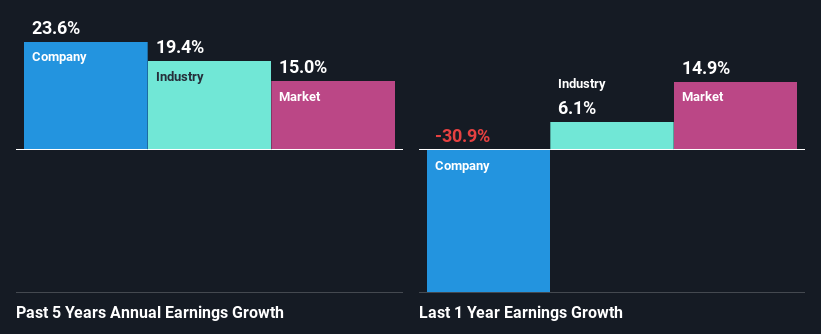Declining Stock and Solid Fundamentals: Is The Market Wrong About Laboratory Corporation of America Holdings (NYSE:LH)?
Laboratory Corporation of America Holdings (NYSE:LH) has had a rough three months with its share price down 11%. However, stock prices are usually driven by a company’s financial performance over the long term, which in this case looks quite promising. In this article, we decided to focus on Laboratory Corporation of America Holdings' ROE.
Return on equity or ROE is a key measure used to assess how efficiently a company's management is utilizing the company's capital. Simply put, it is used to assess the profitability of a company in relation to its equity capital.
View our latest analysis for Laboratory Corporation of America Holdings
How Is ROE Calculated?
ROE can be calculated by using the formula:
Return on Equity = Net Profit (from continuing operations) ÷ Shareholders' Equity
So, based on the above formula, the ROE for Laboratory Corporation of America Holdings is:
19% = US$2.0b ÷ US$10b (Based on the trailing twelve months to June 2022).
The 'return' is the yearly profit. One way to conceptualize this is that for each $1 of shareholders' capital it has, the company made $0.19 in profit.
What Is The Relationship Between ROE And Earnings Growth?
Thus far, we have learned that ROE measures how efficiently a company is generating its profits. Depending on how much of these profits the company reinvests or "retains", and how effectively it does so, we are then able to assess a company’s earnings growth potential. Assuming everything else remains unchanged, the higher the ROE and profit retention, the higher the growth rate of a company compared to companies that don't necessarily bear these characteristics.
A Side By Side comparison of Laboratory Corporation of America Holdings' Earnings Growth And 19% ROE
To begin with, Laboratory Corporation of America Holdings seems to have a respectable ROE. On comparing with the average industry ROE of 15% the company's ROE looks pretty remarkable. This certainly adds some context to Laboratory Corporation of America Holdings' exceptional 24% net income growth seen over the past five years. However, there could also be other causes behind this growth. For example, it is possible that the company's management has made some good strategic decisions, or that the company has a low payout ratio.
Next, on comparing with the industry net income growth, we found that Laboratory Corporation of America Holdings' growth is quite high when compared to the industry average growth of 19% in the same period, which is great to see.
Earnings growth is an important metric to consider when valuing a stock. The investor should try to establish if the expected growth or decline in earnings, whichever the case may be, is priced in. This then helps them determine if the stock is placed for a bright or bleak future. Is Laboratory Corporation of America Holdings fairly valued compared to other companies? These 3 valuation measures might help you decide.
Is Laboratory Corporation of America Holdings Using Its Retained Earnings Effectively?
Laboratory Corporation of America Holdings' three-year median payout ratio to shareholders is 3.4%, which is quite low. This implies that the company is retaining 97% of its profits. This suggests that the management is reinvesting most of the profits to grow the business as evidenced by the growth seen by the company.
Our latest analyst data shows that the future payout ratio of the company is expected to rise to 10% over the next three years. Therefore, the expected rise in the payout ratio explains why the company's ROE is expected to decline to 15% over the same period.
Conclusion
Overall, we are quite pleased with Laboratory Corporation of America Holdings' performance. Specifically, we like that the company is reinvesting a huge chunk of its profits at a high rate of return. This of course has caused the company to see substantial growth in its earnings. With that said, on studying the latest analyst forecasts, we found that while the company has seen growth in its past earnings, analysts expect its future earnings to shrink. To know more about the latest analysts predictions for the company, check out this visualization of analyst forecasts for the company.
Have feedback on this article? Concerned about the content? Get in touch with us directly. Alternatively, email editorial-team (at) simplywallst.com.
This article by Simply Wall St is general in nature. We provide commentary based on historical data and analyst forecasts only using an unbiased methodology and our articles are not intended to be financial advice. It does not constitute a recommendation to buy or sell any stock, and does not take account of your objectives, or your financial situation. We aim to bring you long-term focused analysis driven by fundamental data. Note that our analysis may not factor in the latest price-sensitive company announcements or qualitative material. Simply Wall St has no position in any stocks mentioned.
Join A Paid User Research Session
You’ll receive a US$30 Amazon Gift card for 1 hour of your time while helping us build better investing tools for the individual investors like yourself. Sign up here

 Yahoo Finance
Yahoo Finance 
